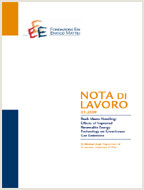Lessons from 15 Years of Experience with the Dutch Tax Allowance for Energy Investments for Firms

30.05.2013
Arjan Ruijs, Herman Vollebergh
H23, H25, H32, O33, Q48
Energy Efficiency, Renewable Energy, Investment, Tax, Tax Preference, Policy Evaluation
Energy: Resources and Markets
Giuseppe Sammarco
Since 1997 the Netherlands has a tax allowance scheme introduced to promote investments in energy saving technologies and sustainable energy production. This Energy Investment Tax Allowance (EIA in Dutch) reduces up-front investment costs for firms investing in the newest energy saving and sustainable energy technologies. The basic design of the EIA has remained the same over the past 15 years. Firms investing in technologies listed in the annually updated ‘Energy List’ may deduct some of the investment costs from their taxable profits. The EIA may also reduce search costs by investors to find particular technologies because of the Energy List which is used to consider eligibility for the subsidy. This Energy List contains generic technologies that meet a certain energy-saving standard or a selection of novel, but proven, technologies with a higher energy-saving potential than conventional technologies. Over the past 15 years, the use of the EIA has been affected by a number of changes, mainly due to exogenous factors, such as interactions with other policy instruments, rising oil and gas prices, and the economic crisis since 2007. Despite this turbulence and changes in government focus, the EIA is still part of the Dutch energy policy mix. Our evaluation of the EIA contains four lessons. First, the use of tax revenues to subsidise investment in energy-efficient technologies and renewable energy is not very different from using on-budget subsidies if budgetary rules require sufficient accountability of such tax expenditures. At the beginning of the scheme, a lack of accountability of tax expenditures contributed to budgetary turbulence. A number of budget overruns in later periods were not related to budget accountability issues, but to changes outside the EIA. Second, incentive compatibility problems of the EIA are of concern but seem to be manageable. The main weakness of the tax allowance is the difficulty to prevent free-riders from receiving subsidies, even though subsidy effectiveness has improved considerably over the years. Third, the use of a dynamic technology list makes the regulation flexible, allowing policy to refocus and apply tighter standards if necessary. The list also reduces the information asymmetry between supply and demand of new technologies and helps suppliers of energy-saving or sustainable energy technologies to overcome the well-known ‘valley of death’. Finally, the design of a subsidy scheme should pay sufficient attention to the likely interaction with other policy instruments, in particular other subsidy schemes aimed at complementary objectives. The turbulence with the EIA over the 2001–2007 period was mainly caused by fluctuations in the application of other instruments.
